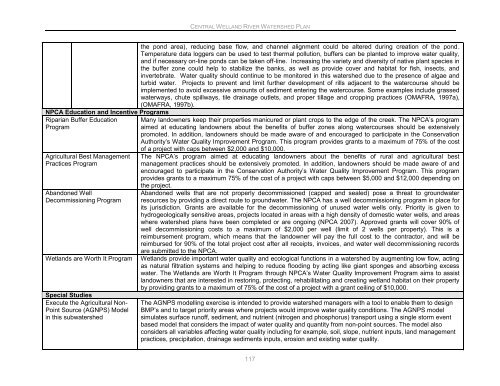Central Welland River Watershed Plan - Niagara Peninsula ...
Central Welland River Watershed Plan - Niagara Peninsula ...
Central Welland River Watershed Plan - Niagara Peninsula ...
- No tags were found...
Create successful ePaper yourself
Turn your PDF publications into a flip-book with our unique Google optimized e-Paper software.
CENTRAL WELLAND RIVER WATERSHED PLANNPCA Education and Incentive ProgramsRiparian Buffer EducationProgramAgricultural Best ManagementPractices ProgramAbandoned WellDecommissioning ProgramWetlands are Worth It ProgramSpecial StudiesExecute the Agricultural Non-Point Source (AGNPS) Modelin this subwatershedthe pond area), reducing base flow, and channel alignment could be altered during creation of the pond.Temperature data loggers can be used to test thermal pollution, buffers can be planted to improve water quality,and if necessary on-line ponds can be taken off-line. Increasing the variety and diversity of native plant species inthe buffer zone could help to stabilize the banks, as well as provide cover and habitat for fish, insects, andinvertebrate. Water quality should continue to be monitored in this watershed due to the presence of algae andturbid water. Projects to prevent and limit further development of rills adjacent to the watercourse should beimplemented to avoid excessive amounts of sediment entering the watercourse. Some examples include grassedwaterways, chute spillways, tile drainage outlets, and proper tillage and cropping practices (OMAFRA, 1997a),(OMAFRA, 1997b).Many landowners keep their properties manicured or plant crops to the edge of the creek. The NPCA‟s programaimed at educating landowners about the benefits of buffer zones along watercourses should be extensivelypromoted. In addition, landowners should be made aware of and encouraged to participate in the ConservationAuthority‟s Water Quality Improvement Program. This program provides grants to a maximum of 75% of the costof a project with caps between $2,000 and $10,000.The NPCA‟s program aimed at educating landowners about the benefits of rural and agricultural bestmanagement practices should be extensively promoted. In addition, landowners should be made aware of andencouraged to participate in the Conservation Authority‟s Water Quality Improvement Program. This programprovides grants to a maximum 75% of the cost of a project with caps between $5,000 and $12,000 depending onthe project.Abandoned wells that are not properly decommissioned (capped and sealed) pose a threat to groundwaterresources by providing a direct route to groundwater. The NPCA has a well decommissioning program in place forits jurisdiction. Grants are available for the decommissioning of unused water wells only. Priority is given tohydrogeologically sensitive areas, projects located in areas with a high density of domestic water wells, and areaswhere watershed plans have been completed or are ongoing (NPCA 2007). Approved grants will cover 90% ofwell decommissioning costs to a maximum of $2,000 per well (limit of 2 wells per property). This is areimbursement program, which means that the landowner will pay the full cost to the contractor, and will bereimbursed for 90% of the total project cost after all receipts, invoices, and water well decommissioning recordsare submitted to the NPCA.Wetlands provide important water quality and ecological functions in a watershed by augmenting low flow, actingas natural filtration systems and helping to reduce flooding by acting like giant sponges and absorbing excesswater. The Wetlands are Worth It Program through NPCA‟s Water Quality Improvement Program aims to assistlandowners that are interested in restoring, protecting, rehabilitating and creating wetland habitat on their propertyby providing grants to a maximum of 75% of the cost of a project with a grant ceiling of $10,000.The AGNPS modelling exercise is intended to provide watershed managers with a tool to enable them to designBMP‟s and to target priority areas where projects would improve water quality conditions. The AGNPS modelsimulates surface runoff, sediment, and nutrient (nitrogen and phosphorus) transport using a single storm eventbased model that considers the impact of water quality and quantity from non-point sources. The model alsoconsiders all variables affecting water quality including for example, soil, slope, nutrient inputs, land managementpractices, precipitation, drainage sediments inputs, erosion and existing water quality.117
















